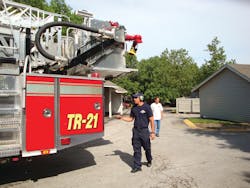Technology Aids Apparatus Backing
We have often commented that backing accidents are almost always preventable and they occur with frightening regularity. Not many months go by without reading or hearing about yet another firefighter being seriously injured or killed when backed over by another firefighter.
This month is no different. As I write this column, a 45-year-old firefighter/EMT is in stable condition with fractures after a fire department member accidentally backed over her with a medium-duty rescue truck. The injured firefighter was walking along the side of a road in a spotter position next to the apparatus as it was backing up when she was struck. The truck struck the firefighter at a low rate of speed and partially ran over her. Both the apparatus and the injured firefighter were operating at an EMS incident. The injured firefighter was transported to a local hospital before being airlifted to a trauma center. At the trauma center, a nurse confirmed that the firefighter was in stable condition with a fractured tailbone and possibly a fractured pelvis, and that more tests were being run.
I have been blessed by being invited to teach in many fire departments in many communities across our great country. I have been exposed to many firefighters, fire apparatus, procedures and technologies. On a recent trip, I saw a backup system different from any that I had seen in use before.
We go now to Johnson County, KS, where I found Consolidated Fire District Truck 21, which is equipped with wired headsets with a receptacle at the rear of the apparatus (photo 1). This system enables the backer to have visual and voice communication with the apparatus operator (photo 2). Note that the operator, even with voice contact, is still intently watching the mirrors; hence, watching the spotter, which is really important to do. This is especially important, for example, with a large mid-mounted tower ladder in a very tight spot in a condominium complex parking lot (photo 3). This system certainly makes operating in such tight quarters much safer and makes it far less likely to have an accident. It seems to me as I watched this take place that the headsets solidify the team concept and direct the attention of the backer and the operator to the task at hand and prevent distractions.
This was the first time that I had experienced backing the apparatus with the aid of headset communications; however, one of the class participants said, "You haven't seen anything yet. I will take pictures of a wireless communication system and send them to you," which he did (photo 4). I tend to like this system even better as the spotter can be farther away from the apparatus and farther to the side of the apparatus, making backing over the spotter far less likely. Take note of the position of the head and eyes of the operator of this apparatus equipped with bus mirrors (photo 5). The operator appears to be looking ahead rather than to the side, as in photo 3. But with that said, both operators present the same high level of attention and concentration. (I would like to thank Jeff DeBell of the Consolidated Fire District and Captain Brad Davis and crew from Johnson County, KS, Fire District 2, Spring Hill Station 84, for photos 4 and 5.)
November is a transition month in many areas. On many days and nights, roadways will be shrouded in fog with very limited visibility or, in some cases, no visibility at all. Leaves will be falling from trees in the rain, creating roadways that will be extremely slippery and would rival any ice-coated road in winter. This is also the season when many male animals, including the white tail deer in my neck of the woods, will be going into rut and chasing female animals. Some, unfortunately, will wind up on roadways, perhaps in your path. Please drive with a heightened state of awareness for all of these hazards as November is one of the most dangerous months in which to drive.
MICHAEL WILBUR, a Firehouse® contributing editor, is a lieutenant in the New York City Fire Department, assigned to Ladder Company 27 in the Bronx, and has served on the FDNY Apparatus Purchasing Committee. He consults on a variety of apparatus-related issues around the country. For further information, access Wilbur's website at www.emergencyvehicleresponse.com.
